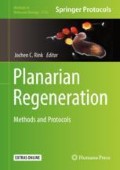Abstract
SILAC (stable isotope labeling by amino acids in cell culture) proteomics enables the relative quantification of proteins in one or more biological samples by mass spectrometry. This technology is based on the metabolic incorporation of heavy isotope-labeled essential amino acids into nascent proteins in vivo. Here, we describe the preparation of SILAC protein samples from planarians, flatworms with high regenerative potential and tissue plasticity. Applications for SILAC proteomics of planarians include the analysis of protein abundances, protein–protein interactions and turnover rates during stem cell-based regeneration and tissue homeostasis.
Access this chapter
Tax calculation will be finalised at checkout
Purchases are for personal use only
References
Sandmann T, Vogg MC, Owlarn S, Boutros M, Bartscherer K (2011) The head-regeneration transcriptome of the planarian Schmidtea mediterranea. Genome Biol 12(8):R76
Solana J, Kao D, Mihaylova Y, Jaber-Hijazi F, Malla S, Wilson R, Aboobaker A (2012) Defining the molecular profile of planarian pluripotent stem cells using a combinatorial RNAseq, RNA interference and irradiation approach. Genome Biol 13(3):R19
Wenemoser D, Lapan SW, Wilkinson AW, Bell GW, Reddien PW (2012) A molecular wound response program associated with regeneration initiation in planarians. Genes Dev 26(9):988–1002
Vogg MC, Owlarn S, Pérez Rico YA, Xie J, Suzuki Y, Gentile L, Wu W, Bartscherer K (2014) Stem cell-dependent formation of a functional anterior regeneration pole in planarians requires Zic and Forkhead transcription factors. Dev Biol 390(2):136–148
Vasquez-Doorman C, Petersen CP (2014) zic-1 expression in planarian neoblasts after injury controls anterior pole regeneration. PLoS Genet 10(7):e1004452
Ong SE, Blagoev B, Kratchmarova I, Kristensen DB, Pandey A, Mann M (2002) Stable isotope labeling by amino acids in cell culture, SILAC, as a simple and accurate approach to expression proteomics. Mol Cell Proteomics 1(5):376–386
Krüger M, Thievessen I, Luber CA, Forner F, Schmidt S, Zanivan S, Fässler R, Mann M (2008) SILAC mouse for quantitative proteomics uncovers kindlin-3 as an essential factor for red blood cell function. Cell 134(2):353–364
Sury MD, Chen JX, Selbach M (2010) The SILAC fly allows for accurate protein quantification in vivo. Mol Cell Proteomics 9(10):2173–2183
Westman-Brinkmalm A, Abramsson A, Pannee J, Gang C, Gustavsson MK, von Otter M, Blennow K, Brinkmalm G, Heumann H, Zetterberg H (2011) SILAC zebrafish for quantitative analysis of protein turnover and tissue regeneration. J Proteome 75(2):425–434
Looso M, Borchardt T, Krüger M, Braun T (2010) Advanced identification of proteins in uncharacterized proteomes by pulsed in vivo stable isotope labeling-based mass spectrometry. Mol Cell Proteomics 9(6):1157–1166
Larance M, Bailly AP, Pourkarimi E, Hay RT, Buchanan G, Coulthurst S, Xirodimas DP, Gartner A, Lamond AI (2011) Stable-isotope labeling with amino acids in nematodes. Nat Methods 8:849–851
Böser A, Drexler HC, Reuter H, Schmitz H, Wu G, Schöler HR, Gentile L, Bartscherer K (2013) SILAC proteomics of planarians identifies Ncoa5 as a conserved component of pluripotent stem cells. Cell Rep 5(4):1142–1155
Geiger T, Kruger M, Ishihama Y, Mann M (2011) Use of stable isotope labeling by amino acids in cell culture as a spike-in standard in quantitative proteomics. Nat Protoc 6(2):147–157
Zanivan S, Meves A, Behrendt K, Schoof EM, Neilson LJ, Cox J, Tang HR, Kalna G, van Ree JH, van Deursen JM, Trempus CS, Machesky LM, Linding R, Wickström SA, Fässler R, Mann M (2013) In vivo SILAC-based proteomics reveals phosphoproteome changes during mouse skin carcinogenesis. Cell Rep 3(2):552–566
Thomas SN, Wan Y, Liao Z, Hanson PI, Yang AJ (2011) A SILAC-based mass spectrometry approach to detect transient protein interactions using substrate trapping. Anal Chem 83(14):5511–5518
Cox J, Mann M (2008) MaxQuant enables high peptide identification rates, individualized p.p.b.-range mass accuracies and proteome-wide protein quantification. Nat Biotechnol 26(12):1367–1372
Hubner NC, Mann M (2011) Extracting gene function from protein-protein interactions using Quantitative BAC InteraCtomics (QUBIC). Methods 53(4):453–459
Wiśniewski JR, Zougman A, Mann M (2009) Combination of FASP and StageTip-based fractionation allows in-depth analysis of the hippocampal membrane proteome. J Proteome Res 8(12):5674–5678
Rappsilber J, Ishihama Y, Mann M (2003) Stop and go extraction tips for matrix-assisted laser desorption/ionization, nanoelectrospray, and LC/MS sample pretreatment in proteomics. Anal Chem 75(3):663–670
Wessel D, Flügge UI (1984) A method for the quantitative recovery of protein in dilute solution in the presence of detergents and lipids. Anal Biochem 138(1):141–143
Wang Y, Yang F, Gritsenko MA, Wang Y, Clauss T, Liu T, Shen Y, Monroe ME, Lopez-Ferrer D, Reno T, Moore RJ, Klemke RL, Camp DG 2nd, Smith RD (2011) Reversed-phase chromatography with multiple fraction concatenation strategy for proteome profiling of human MCF10A cells. Proteomics 11(10):2019–2026
Acknowledgments
We thank S. Zanivan and M. Mann for sharing advice and SILAC mouse liver. This work was supported by the Max Planck Society and the Deutsche Forschungsgemeinschaft (SFB629, PAK479). The Bartscherer lab is part of the Cells-in-Motion Cluster of Excellence (EXC 1003-CiM) and is funded by the European Research Council (ERC-2016-StG 716894 IniReg). We thank J. Rink for helpful comments on the manuscript.
Author information
Authors and Affiliations
Corresponding author
Editor information
Editors and Affiliations
Rights and permissions
Copyright information
© 2018 Springer Science+Business Media, LLC, part of Springer Nature
About this protocol
Cite this protocol
Böser, A., Drexler, H.C.A., Bartscherer, K. (2018). Tissue Extracts for Quantitative Mass Spectrometry of Planarian Proteins Using SILAC. In: Rink, J. (eds) Planarian Regeneration. Methods in Molecular Biology, vol 1774. Humana Press, New York, NY. https://doi.org/10.1007/978-1-4939-7802-1_24
Download citation
DOI: https://doi.org/10.1007/978-1-4939-7802-1_24
Published:
Publisher Name: Humana Press, New York, NY
Print ISBN: 978-1-4939-7800-7
Online ISBN: 978-1-4939-7802-1
eBook Packages: Springer Protocols

